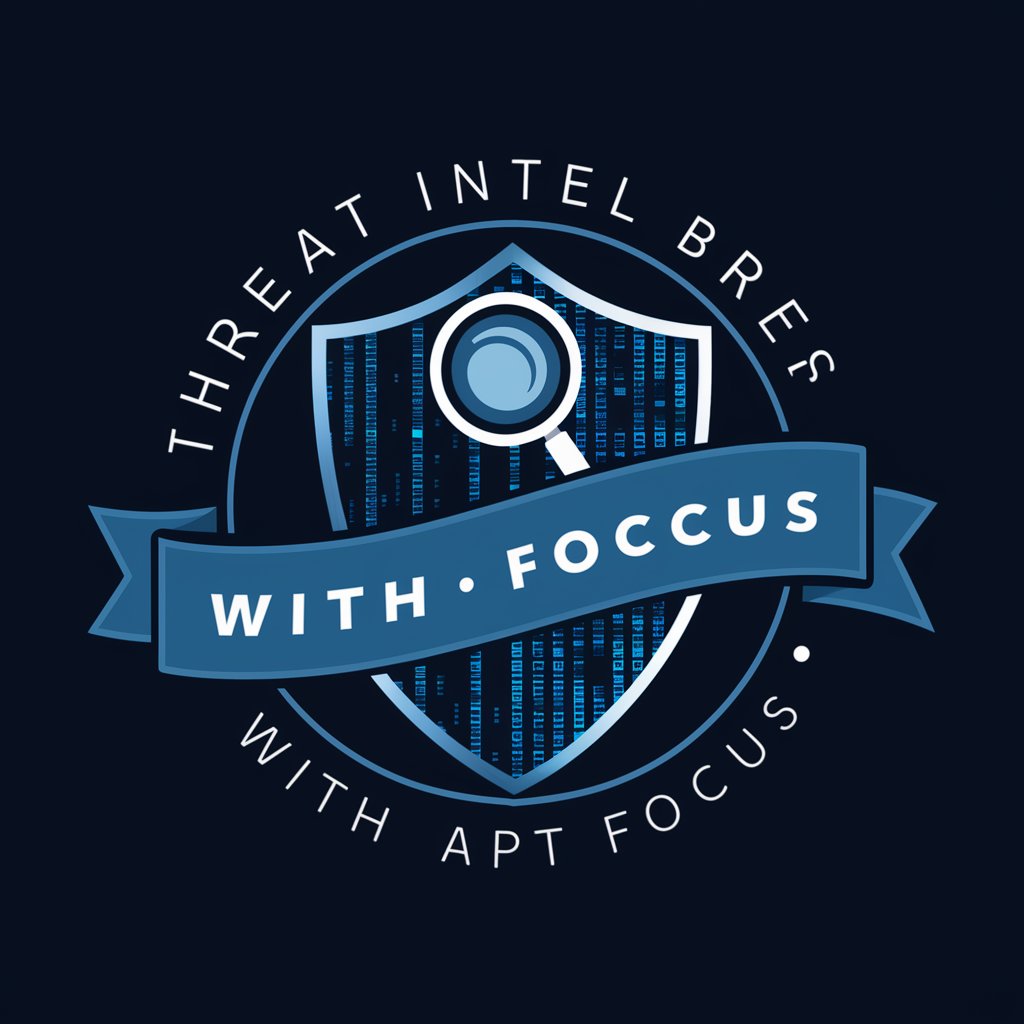
Threat Intel Briefs - Cybersecurity Intelligence Tool

Welcome to Threat Intel Briefs, your trusted source for daily APT insights.
AI-Powered Cybersecurity Threat Insights
Daily Threat Brief: Finance Sector - [Date]
Current APT Activities in the Energy Sector - [Date]
Mitigation Strategies for Healthcare Cyber Threats - [Date]
Emerging Threats in the Technology Sector - [Date]
Get Embed Code
Introduction to Threat Intel Briefs
Threat Intel Briefs are specialized AI tools designed to provide comprehensive, sector-specific cybersecurity threat intelligence briefings. They emphasize Advanced Persistent Threat (APT) groups and operations. The core purpose of these briefs is to offer a concise yet detailed overview of the current cybersecurity landscape, focusing particularly on significant APTs. They serve as a crucial resource for organizations seeking to understand and mitigate the risks posed by these sophisticated threat actors. For example, a Threat Intel Brief might analyze a recent APT operation targeting the financial sector, detailing the tactics, techniques, and procedures (TTPs) used, along with the specific vulnerabilities exploited. Powered by ChatGPT-4o。

Main Functions of Threat Intel Briefs
Sector-Specific Cybersecurity Analysis
Example
Analyzing threats targeting the healthcare industry, including ransomware attacks on hospital systems.
Scenario
Providing real-time analysis of a ransomware campaign targeting hospital systems, detailing the attack vectors, and suggesting immediate response measures.
Detailed APT Group Profiling
Example
Profiling APT28, a group known for cyber espionage, and analyzing their recent activities.
Scenario
Offering an in-depth analysis of APT28’s recent cyber espionage campaign against government agencies, highlighting their methods and potential objectives.
Actionable Mitigation Advice
Example
Recommending specific security protocols to counter a sophisticated phishing campaign.
Scenario
Advising an organization on implementing advanced email filtering and employee training in response to a complex phishing scheme identified in the sector.
Ideal Users of Threat Intel Brief Services
Cybersecurity Professionals
These include security analysts, CISOs, and IT managers who require up-to-date information on cyber threats to protect their organizations’ digital assets.
Government Agencies
Agencies responsible for national security, defense, and cyber warfare defense often utilize Threat Intel Briefs for insights into potential cyber threats and state-sponsored cyber activities.
Academic Researchers
Researchers focusing on cybersecurity, information technology, and international relations find these briefs valuable for understanding evolving cyber threat landscapes and APT group tactics.

Guidelines for Using Threat Intel Briefs
Initial Access
Visit yeschat.ai for a free trial without requiring a login, and no need for ChatGPT Plus.
Understand the Scope
Familiarize yourself with the capabilities of Threat Intel Briefs, particularly its focus on Advanced Persistent Threat (APT) groups and sector-specific cybersecurity intelligence.
Identify Your Needs
Determine the specific sector or type of cybersecurity threats you are interested in. This will help tailor the briefs to your specific requirements.
Regular Engagement
Engage with the briefs daily to stay updated on the latest threats and trends. Regular engagement ensures you don't miss critical updates.
Apply Recommendations
Implement the actionable mitigation advice provided in the briefs to enhance your cybersecurity posture and resilience against threats.
Try other advanced and practical GPTs
LyriGuru
Unravel the story behind every song

AIProductGPT: Add AI to your Product
Elevating Products with Smart AI Integration

Assistant [Ad-supported Tier]
Empowering Conversations with AI
![Assistant [Ad-supported Tier]](https://r2.erweima.ai/i/VaTweOYxS6q4MdwuFsD1fA.png)
LiDAR AI - LAStools helper
Elevate Your LiDAR Data Processing with AI

Qu'aurait dit Charles de Gaulle ?
Experience de Gaulle's Vision Through AI

SEOptimizer
Optimize Your Web Presence with AI

Text-Only Social Media Image Creator
Elevate your social media with AI-powered text images.

Tech Writer
Elevate Your Writing with AI Precision

Critter Creator
Bringing Your Imaginary Critters to Life

Starship Colony GPT
Navigate the stars with AI-powered game wisdom.

Digital ICP Assistant
Unraveling the 'Why' with AI

Prompt Optimizer for Product Images
Envision and Enhance Product Visuals with AI

Frequently Asked Questions about Threat Intel Briefs
What are Threat Intel Briefs?
Threat Intel Briefs are daily cybersecurity intelligence reports, focusing on Advanced Persistent Threat (APT) groups and sector-specific threats. They provide a comprehensive analysis of the current threat landscape, actionable recommendations, and key takeaways.
How current is the information in the briefs?
The briefs contain the latest, verified information from reputable sources. Regular updates ensure the information is current and relevant to the evolving cybersecurity landscape.
Can Threat Intel Briefs be customized for specific sectors?
Yes, the briefs are tailored to provide sector-specific intelligence, ensuring relevance and applicability to your specific area of interest or industry.
What kind of recommendations do the briefs offer?
The briefs offer actionable mitigation advice to address tactics and vulnerabilities exploited by threat actors, helping enhance your cybersecurity strategies and defenses.
How do I ensure I'm making the most of Threat Intel Briefs?
Regular engagement with the briefs, applying the provided recommendations, and keeping abreast of the evolving threat landscape are key to maximizing the benefits of Threat Intel Briefs.





